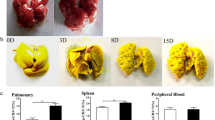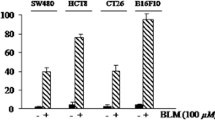Abstract
We previously reported that reactive oxygen species (ROS) enhance tumor cell metastasis, and by administration of recombinant human superoxide dismutase (rh SOD), an enzyme which scavenges \({\text{O}}_{\text{2}}^ - \) successfully reduced lung metastasis of mouse MethA sarcoma and Lewis lung carcinoma. These observations suggested that rh SOD suppressed tumor cell invasion by eliminating \({\text{O}}_{\text{2}}^ - \), the primary source of ROS. However, for the clinical application of the drug as an anti metastatic agent, rh SOD needs to be administered in combination with other cytotoxic agents, since SOD by itself has no cytotoxic activity. In this paper, we investigated the effectiveness of the combination chemotherapy of rh SOD and adriamycin (ADR), an anti-cancer agent against the experimental metastasis of highly metastatic clone, MH-02, which was derived from murine Meth A sarcoma. The present metastasis experiment clearly indicates that the administration of rh SOD enhances the anti-metastatic effect of ADR. On the other hand, we found that the inhibition rate of metastasis exhibited by the combination chemotherapy of rh SOD and a certain dose (5 mg/ml) of ADR was inferior to that of rh SOD. This apparent paradoxical phenomenon was presumably explained by our finding that tumor cells themselves augment their invasive capacity and platelet aggregation, both of which are causative factors for metastasis formation, by generation of \({\text{O}}_{\text{2}}^ - \) when they were treated with ADR. Nevertheless, the combination chemotherapy of SOD with anticancer drugs such as ADR can be a practical anti-metastasis strategy.
Similar content being viewed by others
References
Liotta LA, Kohn E. Tumor invasion and metatstasis: biochemical mechanisms. Treatment Res Cancer 1988; 40: 223–38.
Babior BM, Kipner RS, Curnutte JT. Biological defense mechanisms: the production by leukocytes of superoxide dismutase, a potential bacteriocidal agent. J Clin Invest 1973; 5: 741–4.
Drath DB, Kranovsky ML. Superoxide production by phagocytic leukocytes. J Exp Med 1975; 141: 257–62.
Yoshizaki N, Mogi Y, Muramatsu H, Koike K, Kogawa K, Niitsu Y. Suppressive effect of recombinant human cu, zn-superoxide dismutase on lung metastasis of murune tumor cells. Int J Cancer 1994; 57: 287–92.
Muramatsu H, Kogawa K, Tanaka M, Okumura K, Nishihori Y, Koike K, Kuga T, Niitsu Y. Superoxide dismutase in SAS human tongue carcinoma cell line is a factor defining invasiveness and cell motility. Cancer Res 1995; 55: 6210–4.
Tanaka M, Kogawa K, Nishihori Y, Kuribayashi K, Nakamura K, Muramatsu H, Koike K, Sakamaki S, Niitsu Y. Suppression of intracellular Cu-Zn SOD results in enhanced motility and metastasis of Meth A sarcoma cells. Int J Cancer 1997; 73: 187–92.
Adamson IY, Young L, Orr FW. Tumor metastasis after hyperoxicinjury and repair of the pulmonary endothelium. Lab Invest 1987; 57: 71–7.
Orr FW, Adamson IYR, Wamer D, Leroyer V, Werner L, Shaghnessy S, Young L. The effect of oxygen radical mediated pulmonary endothelial damage on cancer metastasis. Mol Cell Biochem 1988; 84: 189–98.
Shinkai K, Mukai M, Akedo H. Superoxide radical potentiates invasive capacity of rat ascites hepatoma cells in vitro. Cancer Lett 1986; 32: 7–13.
Imamura F, Horai T, Mukai M, Shinkai K, Akedo H. Potentiation of invasive capacity of rat ascites hepatoma cells by adriamycin. Cancer Res 1990; 50: 2018–21.
Mogi Y, Kogawa K, Takayama T, Yoshizaki N, Bannai K, Murainatsu H, Koike K, Kohgo Y, Watanabe N, Niitsu Y. Platelet aggregation induced by adenosine diphosphate released from cloned murine fibrosarcoma cells is positively correlated with the experimental metastatic potential of the cells. Jpn J Cancer Res 1991; 192–8.
Okamoto T, Watanabe N, Yamauchi N, Tsuji Y, Itoh Y, Neda H, Niitsu Y. Endogenous tumor necrosis factor exerts its protective function intracellularly against the cytotoxicity of exogenous tumor necrosis factor. Cancer Res 1992; 52: 5278–81.
Albini A, Iwamoto Y, Kleinman HK, Martin GR, Aaron SA, Kozlowski JM, McEwan RN. A rapid in vitro assay for quantitating the invasive potential of tumor cells. Cancer Res 1987; 3239–45.
Vowells SJ, Sekhsaria S, Malech HL, Shalit M, Fleisher TA. Flowcytometric analysis of the granulocyte respiratory burst; a comparison study of fluorescent probes. J Immunol Methods 1995; 178: 89–97.
Niitsu Y, Ishigaki S, Kogawa K, Mogi Y, Watanabe N, Kohgo Y, Urushizaki I. Effect of combined administration of a prostacyclin analogue and adriamycin against the artificial metastasis of Meth A cell. Invasion Metastasis 1988; 8: 57–72.
Kalyanaraman B, Morehouse KM, Mason RP. An electron paramagnetic resonance study of the interactions between the adriamycin semiquinone, hydrogen peroxide, ion-chelators, and radical scavengers. Arch Biochem Biophys 1991; 286: 164–70.
Sundaresan M, Yu Z-X, Ferrans VJ, Irani K, Finkel T. Requirement for generation of H202 for platelet-derived growth factor signal transduction. Science 1995; 270: 296–9.
Salvemini D, de Nucci G, Sheddon JM, Vane JR. Superoxide anions enhance platelet adhesion and aggregation. Br J Pharmacol 1989; 97: 1145–50.
Pignateli P, Pulcineli FM, Lenti L, Gazzaniga PP, Violi F. Hydrogen peroxide is involved in collagen-induced platelet activation. Blood 1998; 91: 484–90.
Rosenfeld W, Evans H, Jhaveri R, Moainie H, Vohra K, Georgatos E, Salazar JD. Safety and plasma concentration of bovine superoxide dismutase. Developmental Pharmacol Therapeutics 1982; 5: 151–61.
Author information
Authors and Affiliations
Rights and permissions
About this article
Cite this article
Kogawa, K., Muramatsu, H., Tanaka, M. et al. Enhanced inhibition of experimental metastasis by the combination chemotherapy of Cu-Zn SOD and adriamycin. Clin Exp Metastasis 17, 239–244 (1999). https://doi.org/10.1023/A:1006633616629
Issue Date:
DOI: https://doi.org/10.1023/A:1006633616629




